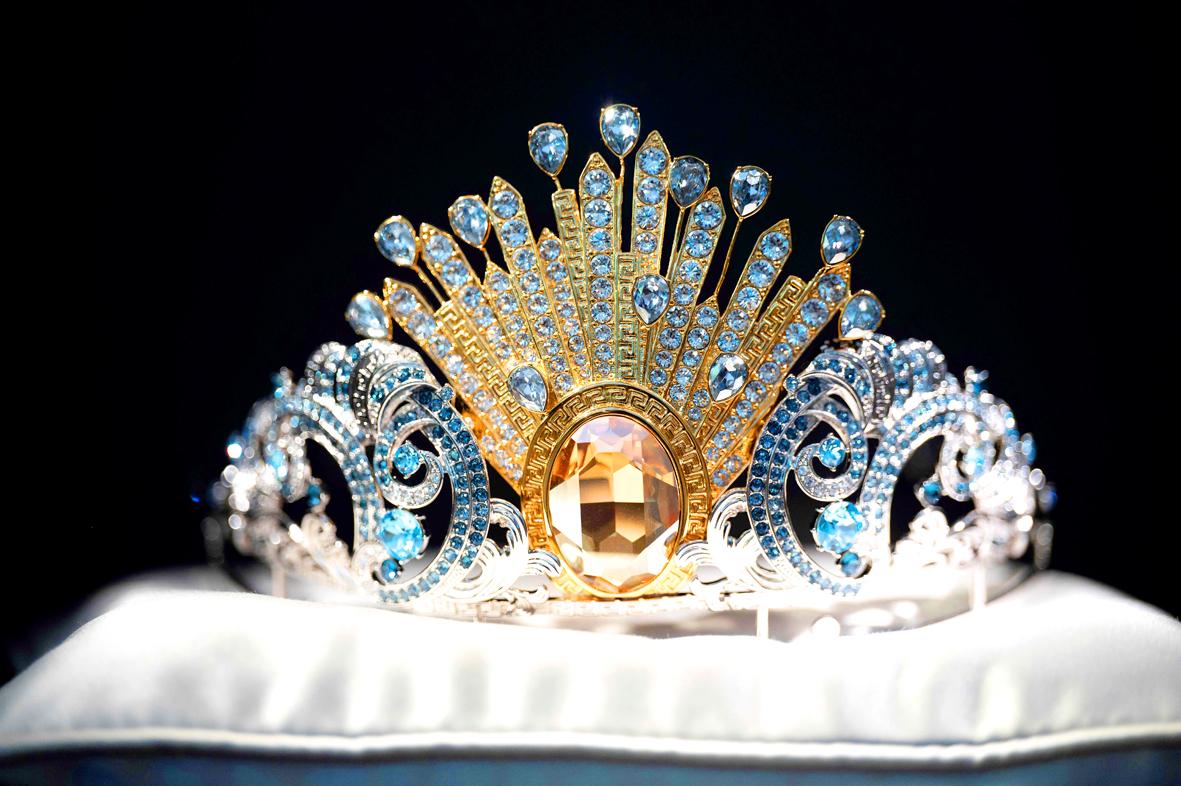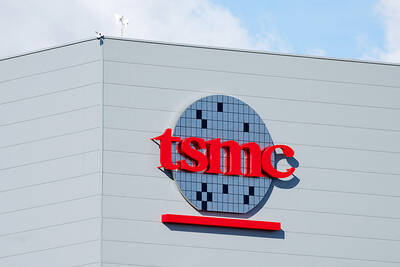Crystal-studded clouds reflected in a pond, an oversized crystal chandelier surrounded by mirrors: The headquarters of the Swarovski AG crystal empire are every bit as glitzy as one might expect — but the sparkle cannot distract from a bitter family feud over the company’s future.
Normally, 650,000 tourists flock to the site in the town of Wattens in Austria’s mountainous Tyrol region every year, but the COVID-19 pandemic has not only left it deserted — it has also magnified much deeper issues for the company.
Exactly 125 years after founder Daniel Swarovski developed a machine to cut glass to shimmer like diamonds, his great-great grandchildren now reign over a diversified operation — offering rhinestones to fashion brands, binoculars to hunters, and jewelry and crystal figurines of characters from Mickey Mouse to Princess Leia.

Photo: AFP
However, chief executive officer Robert Buchbauer said that drastic change is needed.
“We are forced to reimagine and rescale our entire Swarovski business,” Buchbauer said at the Wattens headquarters.
Swarovski’s crystals might have adorned the outfits of celebrities such as Beyonce and Marilyn Monroe, and been used by designers including Christian Dior, but Buchbauer said that among business clients they are losing their luster.
Crystals made by competitors in China sparkle just as brightly — for as little as 1 percent of the price.
To this already ruinous competition, the pandemic has added “sales shortfalls on a gigantic scale,” Buchbauer said.
Overall revenues for crystals are projected to plummet by 30 percent from 2.7 billion euros (US$3.3 billion) last year to about 1.9 billion euros this year.
Long-planned, sweeping cuts have only become more urgent, Buchbauer said.
He wants to make Swarovski’s crystals more exclusive, producing fewer, larger and more colorful products that can be sold for more.
Mass-market products such as manicure sets and mobile-phone cases graced with Swarovski crystals might have given the company a wide appeal, but they have no place in the future, he said.
Neither would about 750 of its 3,000 stores worldwide. The downsizing would also mean laying off about 6,000 employees.
The plans are already under way, with about 1,200 employees in Wattens losing their jobs this year and a further 600 posts expected to go next year.
Buchbauer said that unless his plans are executed in full, “we’ll end up among the losers.”
Other clan members are convinced that customers who have been turning to cheaper competitors would not pay higher prices.
Paul Swarovski, a shareholder and former member of the executive board, said that he wants to stop Buchbauer’s plans “before everything goes down the drain.”
He has been joined by Nadja Swarovski, one of three members of the executive board, as well as her father Helmut Swarovski and her uncle Gerhard Swarovski.
In the cut-throat luxury goods industry, Swarovski is one of few entirely family owned businesses left run as a limited partnership.
Initially this was a useful structure for a small-scale manufacturer, but all sides agree it is now an impediment for the international, multibillion-euro operation.
Buchbauer, who became Swarovski’s first ever chief executive officer in April, won approval from shareholders for his own proposal which would bring the Wattens operations under the umbrella of a holding company.
The plan won the backing of family members holding about 80 percent of shares — a “legally effective” decision, said Buchbauer, who stands to gain more power from the change.
Nadja, Helmut, Gerhard and Paul Swarovski and others objected, saying that the roughly 20 percent of shares they hold gives them veto power.
They have filed for arbitration, hoping that Buchbauer’s move will be nullified.
Paul Swarovski insists that Buchbauer must go.
“As long as the captain who is steering us toward a reef has his hands at the tiller, one has to make sure to get him away from the tiller,” he said.
Meanwhile, members of the clan posting photographs of luxury holidays on social media or descending from helicopters for meetings in Wattens have only added to the frustration and disbelief of employees, union representative Selina Staerz said.
“We don’t feel like we are the heart of the company anymore,” Staerz said in between advice sessions for laid-off staff.
In a region otherwise dependent on tourism where Swarovski is the single largest employer, ex-employees could struggle to find new jobs.
Although Buchbauer said that no further cuts would be necessary after next year, rumors persist that the whole operation would be transferred to neighboring Switzerland.
Either way, Staerz said, people have lost faith in an employer once lauded for providing benefits such as childcare and housing.
Moreover, she said that many staff do not believe that Swarovski will succeed in becoming an affordable luxury brand.
“The super wealthy don’t need our Swarovski crystals. They can buy diamonds,” she said.

Taiwan Semiconductor Manufacturing Co (TSMC, 台積電) secured a record 70.2 percent share of the global foundry business in the second quarter, up from 67.6 percent the previous quarter, and continued widening its lead over second-placed Samsung Electronics Co, TrendForce Corp (集邦科技) said on Monday. TSMC posted US$30.24 billion in sales in the April-to-June period, up 18.5 percent from the previous quarter, driven by major smartphone customers entering their ramp-up cycle and robust demand for artificial intelligence chips, laptops and PCs, which boosted wafer shipments and average selling prices, TrendForce said in a report. Samsung’s sales also grew in the second quarter, up

LIMITED IMPACT: Investor confidence was likely sustained by its relatively small exposure to the Chinese market, as only less advanced chips are made in Nanjing Taiwan Semiconductor Manufacturing Co (TSMC, 台積電) saw its stock price close steady yesterday in a sign that the loss of the validated end user (VEU) status for its Nanjing, China, fab should have a mild impact on the world’s biggest contract chipmaker financially and technologically. Media reports about the waiver loss sent TSMC down 1.29 percent during the early trading session yesterday, but the stock soon regained strength and ended at NT$1,160, unchanged from Tuesday. Investors’ confidence in TSMC was likely built on its relatively small exposure to the Chinese market, as Chinese customers contributed about 9 percent to TSMC’s revenue last

With this year’s Semicon Taiwan trade show set to kick off on Wednesday, market attention has turned to the mass production of advanced packaging technologies and capacity expansion in Taiwan and the US. With traditional scaling reaching physical limits, heterogeneous integration and packaging technologies have emerged as key solutions. Surging demand for artificial intelligence (AI), high-performance computing (HPC) and high-bandwidth memory (HBM) chips has put technologies such as chip-on-wafer-on-substrate (CoWoS), integrated fan-out (InFO), system on integrated chips (SoIC), 3D IC and fan-out panel-level packaging (FOPLP) at the center of semiconductor innovation, making them a major focus at this year’s trade show, according

DEBUT: The trade show is to feature 17 national pavilions, a new high for the event, including from Canada, Costa Rica, Lithuania, Sweden and Vietnam for the first time The Semicon Taiwan trade show, which opens on Wednesday, is expected to see a new high in the number of exhibitors and visitors from around the world, said its organizer, SEMI, which has described the annual event as the “Olympics of the semiconductor industry.” SEMI, which represents companies in the electronics manufacturing and design supply chain, and touts the annual exhibition as the most influential semiconductor trade show in the world, said more than 1,200 enterprises from 56 countries are to showcase their innovations across more than 4,100 booths, and that the event could attract 100,000 visitors. This year’s event features 17